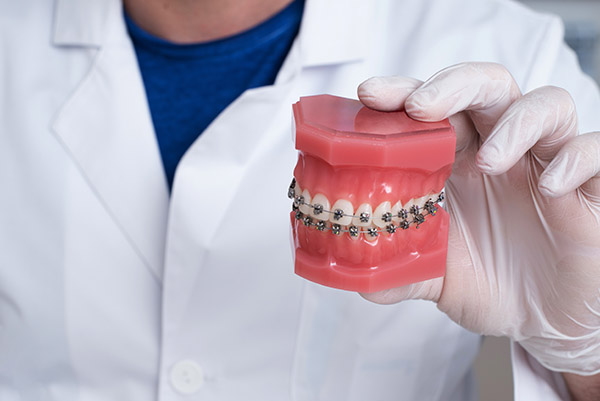How an Orthodontist Uses Elastics for Treatment

Often, the primary focus of treatment from an orthodontist is addressing misaligned teeth. However, jaw misalignments can also cause cosmetic and oral health concerns. To help ensure the adequate correction of jaw alignment, as well as the teeth, orthodontists may use elastics.
How an orthodontist uses elastics during orthodontic treatment
Orthodontists use elastics to treat bite complications such as crossbites, overbites, and underbites. Elastics are used at the same time as braces (or sometimes clear aligners) to allow for quicker results for patients. This review discusses the role of elastics in treating jaw and teeth misalignment through orthodontic care.
What are elastics in orthodontic treatment?
Elastics in orthodontic treatment, also sometimes called inter-arch rubber bands, are stretchable loops that are strategically positioned to keep the upper and lower jaw in the proper position. They are used to correct various bite complications that are common among orthodontic patients. The elastics are generally made of latex material. Elastics are most commonly used with traditional braces, although some clear aligner treatments utilize a variation of elastics to achieve a similar purpose.
When would an orthodontist use elastics?
Orthodontists use elastics to correct bite misalignments for their patients. Treatments such as traditional braces pull teeth into better alignment. However, this is not always enough to correct the jaw misalignment, in which case, elastics are used. Examples of bite complications that an orthodontist may address with elastics include:
- Overbite
- Underbite
- Crossbite
- Open bite
An orthodontist can assess the severity of the misalignment during the consultation or early on in the treatment process and determine what role elastics should play, if any, in the treatment plan.
The importance of wearing elastics if recommended
Not all orthodontic patients are required to wear elastics, although many (if not most) patients will have to at some point during their treatment. Elastics can feel slightly uncomfortable and awkward at first. It is important to not stop wearing the elastics after the initial discomfort, as the jaw misalignment may not improve from the braces or clear aligners treatment alone.
The long-term benefits of wearing elastics
The purpose of elastics is to correct jaw misalignments. In doing so, the patient can improve the appearance of their smile with a more symmetric and even bite. While many are familiar with the cosmetic benefits, fewer are aware of how elastics can improve oral health. People with bite complications are at an increased risk of bruxism, which could damage teeth and increase the risk of temporomandibular joint disorder. Elastics correct the bite, reducing these risks, in addition to creating a more attractive jaw alignment.
Common questions about orthodontic elastics
Here are the answers to some common questions about elastics during orthodontic treatment to help you determine if they are right for you and ensure they are worn properly if they are recommended.
How long does it take for elastics to correct a bite?
This depends on how well the patient follows the orthodontic plan. In most cases, patients are asked to wear their elastics for 24 hours a day, only removing them when it is absolutely necessary. When worn properly, the patient should see and feel noticeable results in approximately seven months, although results may vary widely depending on the severity of the malocclusion and the patient’s age.
What are the dos and don'ts of wearing elastics?
Of course, the most notable instruction for elastics is to wear them as much as possible. Otherwise, the jaw has a tendency to remain in its current alignment. Patients are usually advised to remove them while brushing and eating, but the elastics should be replaced right afterward. It is not recommended to ever double up on your elastics even if you miss a day of wearing them; this is actually counterproductive and may slow the success of treatment.
Do I have to wear elastics while I eat?
Elastics are most effective when they are worn 24/7. This means it is recommended that you wear them while you are eating. However, in cases where eating becomes too challenging because of the elastics, they may be removed. It is important to replace them once you are finished eating.
The bottom line
Here at our orthodontic practice, we do all that we can to ensure that all our patients have a positive experience. If you are not happy with the alignment of your teeth and jaw or are searching for an experienced orthodontist for your child, contact our practice today to schedule a consultation.
Request an appointment here: https://www.orthodonticprecision.com or call Precision Orthodontics & Pediatric Dentistry at (703) 391-8800 for an appointment in our Reston office.
Check out what others are saying about our dental services on Yelp: Orthodontist in Reston, VA.
Recent Posts
Wearing braces gives you a lot to think about leading up to and during the treatment. The process can be successful and produce the results you want. Whether you have crooked teeth, bite problems, or a crowded mouth, you can soon have a new smile. However, there are some important guidelines to follow during this…
Metal braces have been used to straighten teeth for over a century and remain an efficient way to straighten teeth. These oral appliances work by applying constant pressure on your teeth, slowly improving their alignment over 12 to 36 months. The appliance is fixed in your mouth after a dentist installs it, and it stays…
Like braces, clear aligner treatment can successfully straighten teeth and correct bite problems. Braces were the most popular and available choice for many years, but aligners are more common today than ever. If you are unhappy with the way your smile looks, aligners can be effective. Understanding how aligners work and what the process is…
As you prepare to get braces and start wearing them, you may be a little nervous. It can take some time to get used to this treatment. You will encounter some challenges, but the result can help you achieve your goals. During the process, you need to be diligent about caring for your braces. This…


